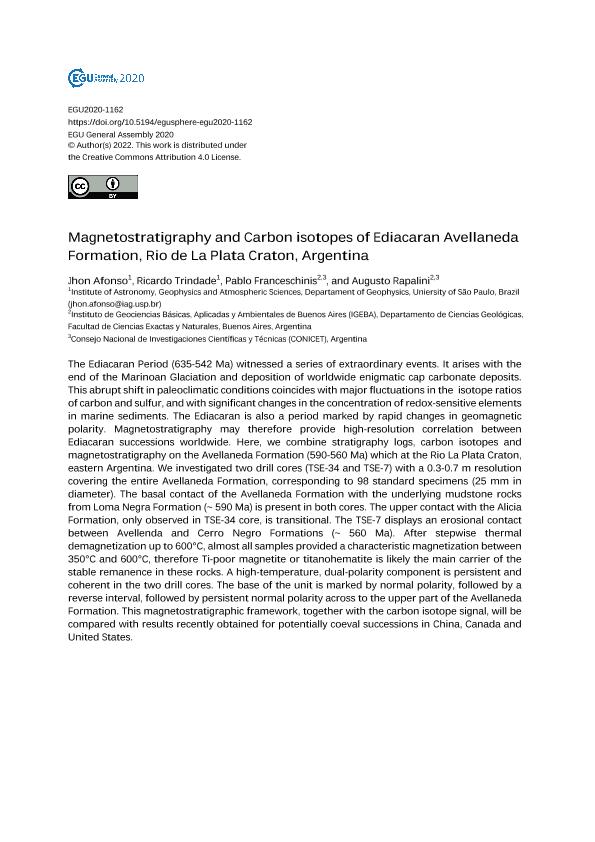Mostrar el registro sencillo del ítem
dc.contributor.author
Afonso, Jhon
dc.contributor.author
Ferreira Da Trindade, Ricardo Ivan

dc.contributor.author
Franceschinis, Pablo Reinaldo

dc.contributor.author
Arrouy, Maria Julia

dc.date.available
2022-10-31T14:20:44Z
dc.date.issued
2020
dc.identifier.citation
Magnetostratigraphy and Carbon isotopes of Ediacaran Avellaneda Formation, Rio de La Plata Craton, Argentina; EGU General Assembly 2020; Austria; 2020; 1-1
dc.identifier.uri
http://hdl.handle.net/11336/175582
dc.description.abstract
The Ediacaran Period (635-542 Ma) witnessed a series of extraordinary events. It arises with the end of the Marinoan Glaciation and deposition of worldwide enigmatic cap carbonate deposits. This abrupt shift in paleoclimatic conditions coincides with major fluctuations in the isotope ratios of carbon and sulfur, and with significant changes in the concentration of redox-sensitive elements in marine sediments. The Ediacaran is also a period marked by rapid changes in geomagnetic polarity. Magnetostratigraphy may therefore provide high-resolution correlation between Ediacaran successions worldwide. Here, we combine stratigraphy logs, carbon isotopes and magnetostratigraphy on the Avellaneda Formation (590-560 Ma) which at the Rio La Plata Craton, eastern Argentina. We investigated two drill cores (TSE-34 and TSE-7) with a 0.3-0.7 m resolution covering the entire Avellaneda Formation, corresponding to 98 standard specimens (25 mm in diameter). The basal contact of the Avellaneda Formation with the underlying mudstone rocks from Loma Negra Formation (~ 590 Ma) is present in both cores. The upper contact with the Alicia Formation, only observed in TSE-34 core, is transitional. The TSE-7 displays an erosional contact between Avellenda and Cerro Negro Formations (~ 560 Ma). After stepwise thermal demagnetization up to 600°C, almost all samples provided a characteristic magnetization between 350°C and 600°C, therefore Ti-poor magnetite or titanohematite is likely the main carrier of the stable remanence in these rocks. A high-temperature, dual-polarity component is persistent and coherent in the two drill cores. The base of the unit is marked by normal polarity, followed by a reverse interval, followed by persistent normal polarity across to the upper part of the Avellaneda Formation. This magnetostratigraphic framework, together with the carbon isotope signal, will be compared with results recently obtained for potentially coeval successions in China, Canada and United States.
dc.format
application/pdf
dc.language.iso
eng
dc.publisher
Copernicus Publications

dc.rights
info:eu-repo/semantics/openAccess
dc.rights.uri
https://creativecommons.org/licenses/by/2.5/ar/
dc.subject
NEOPROTEROZOICO
dc.subject
SISTEMA DE TANDILIA
dc.subject
PALEOMAGNETIC
dc.subject
EDIACARAN
dc.subject.classification
Geología

dc.subject.classification
Ciencias de la Tierra y relacionadas con el Medio Ambiente

dc.subject.classification
CIENCIAS NATURALES Y EXACTAS

dc.title
Magnetostratigraphy and Carbon isotopes of Ediacaran Avellaneda Formation, Rio de La Plata Craton, Argentina
dc.type
info:eu-repo/semantics/publishedVersion
dc.type
info:eu-repo/semantics/conferenceObject
dc.type
info:ar-repo/semantics/documento de conferencia
dc.date.updated
2022-03-17T14:09:24Z
dc.journal.pagination
1-1
dc.journal.pais
Austria

dc.journal.ciudad
Viena
dc.description.fil
Fil: Afonso, Jhon. Universidade de Sao Paulo; Brasil
dc.description.fil
Fil: Ferreira Da Trindade, Ricardo Ivan. Universidade de Sao Paulo; Brasil
dc.description.fil
Fil: Franceschinis, Pablo Reinaldo. Consejo Nacional de Investigaciones Científicas y Técnicas. Oficina de Coordinación Administrativa Ciudad Universitaria. Instituto de Geociencias Básicas, Aplicadas y Ambientales de Buenos Aires. Universidad de Buenos Aires. Facultad de Ciencias Exactas y Naturales. Instituto de Geociencias Básicas, Aplicadas y Ambientales de Buenos Aires; Argentina
dc.description.fil
Fil: Arrouy, Maria Julia. Universidad Nacional del Centro de la Provincia de Buenos Aires. Rectorado. Instituto de Hidrología de Llanuras - Sede Azul. Provincia de Buenos Aires. Gobernación. Comisión de Investigaciones Científicas. Instituto de Hidrología de Llanuras - Sede Azul; Argentina. Consejo Nacional de Investigaciones Científicas y Técnicas. Oficina de Coordinación Administrativa Ciudad Universitaria. Instituto de Geociencias Básicas, Aplicadas y Ambientales de Buenos Aires. Universidad de Buenos Aires. Facultad de Ciencias Exactas y Naturales. Instituto de Geociencias Básicas, Aplicadas y Ambientales de Buenos Aires; Argentina
dc.relation.alternativeid
info:eu-repo/semantics/altIdentifier/url/https://meetingorganizer.copernicus.org/EGU2020/EGU2020-1162.html
dc.relation.alternativeid
info:eu-repo/semantics/altIdentifier/doi/http://dx.doi.org/https://doi.org/10.5194/egusphere-egu2020-1162
dc.conicet.rol
Autor

dc.conicet.rol
Autor

dc.conicet.rol
Autor

dc.conicet.rol
Autor

dc.coverage
Internacional
dc.type.subtype
Congreso
dc.description.nombreEvento
EGU General Assembly 2020
dc.date.evento
2020-05-04
dc.description.paisEvento
Austria

dc.type.publicacion
Journal
dc.description.institucionOrganizadora
European Geosciences Union
dc.source.revista
EGU General Assembly 2020
dc.date.eventoHasta
2020-05-08
dc.type
Congreso
Archivos asociados
